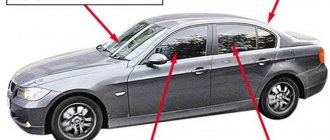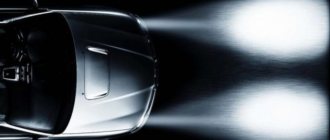What is the fine for tinting headlights in 2021?
Tinted headlights. There are only three colors of lights allowed at the front: white, yellow or orange. If a driver installs green lamps or tints his headlights purple and an inspector notices this, he will be deprived of his license for a period of 6 months to a year.
Alexander Torvard, auto lawyer
If the light bulb itself, which is located under the headlight glass, is painted, the inspector will remove it and attach it to the protocol. If you have tinted headlights, you may send the car to a special parking lot, since you cannot drive a car that does not meet the requirements.
Tinted rear lights. The same thing applies to the taillights - their colors should not differ from the permitted ones:
- license plate lighting and reversing lamp - white;
- the remaining rear lights are white, yellow or orange.
If the colors are different, the driver will be deprived of his license for up to a year. Tinted rear lights are prohibited.
Payment of fines at a discount. There is no monetary administrative fine for tinting lights - only deprivation of rights. This means that there will be no discount.
The discount applies to the fine for tinting the interior windows. Instead of 500 rubles - 250 if you pay in the first 20 days from the date of the decision.
Repeated fine for tinting. By law, a violation is considered repeated if a driver violates the same traffic rule more than once within a year. The list of violations for which repeat penalties are more severe is limited. There is no penalty for tinting on this list.
See our article on fines for repeat offenses for a full list of penalties.
What's the fine?
The fine for tinted light fixtures in our case will be 500 rubles, and in very rare cases it may be limited to a warning. This is provided for by Part 1 of Article 12.5 of the Code of Administrative Offenses, which prescribes punishment for driving a car in the presence of malfunctions listed in the Basic Provisions of the Traffic Regulations.
The logical chain here is simple: the Code of Administrative Offenses refers to the Traffic Regulations Appendix, and the latter, in turn, to the Technical Regulations. In fact, if the safety regulations for wheeled vehicles are violated, then the traffic rules are also violated.
Such a fine can be paid with a 50% discount within 20 days after the decision is made or even later in some cases if this deadline is missed.
Can I avoid a fine if I fix it on the spot?
No. Alas, eliminating the condition leading to the violation on the spot, if possible, is the responsibility of the driver, and it does not affect the fine in any way.
The point here is that, again, traffic rules oblige (clause 2.3.1) the driver to ensure that the vehicle is in good condition on the way. This means that if a malfunction is detected, you are obliged to correct it in any case. But the very fact of the violation - driving the car in the presence of such a malfunction - has already taken place and was recorded by the traffic police inspector, therefore the fine is justified.
Correct tinting of headlights according to GOST
Inspection and tinting of headlights. A technical inspection is necessary to ensure that a car on the road does not cause an accident. If the car's brakes fail at high speed or the windshield washer nozzles break in dirty weather, an accident may occur and people may be injured.
In addition to the engine, brakes and wheels, the inspection station employee will also check the headlights. If there are no coloring elements on them or the lamps themselves, the headlights are considered roadworthy. And vice versa - if, for example, the turn signals are colorless, although according to GOST they should be orange, the owner will be sent to correct the defects. He will have 20 days to do this. They will only check what caused the re-inspection.
Color of headlights and taillights. Front and rear lights can only be white, yellow or orange. The license plate lighting and reversing lamp are only white.
Rules for measuring tint. The guest talks about measuring only the strength and width of the beam of light from the headlights - high and low. The color of the headlights should be white, yellow or orange. A diagnostic center employee will look at the headlights, compare them with what is allowed, and continue the check, or send the driver to correct the problem.
If a traffic police officer sees a car on the road with headlights of a color different from those permitted, he will stop the car and inspect the headlights - no special equipment is needed here. If the color really does not match the permitted color, the inspector will make sure that it was not a glare or an optical illusion, and will issue a violation report. The driver will be deprived of his license.
To determine the color, the inspector needs special instruments - just look at the headlights in good lighting
When is headlight tinting appropriate?
To figure out whether tinting headlights is allowed, you first need to decide on the feasibility of carrying out this type of procedure. It should be noted right away that tinting a vehicle’s light fixtures is more of a fashion statement than a vital necessity.
The color of the headlight tinting can be in harmony with the overall color scheme of the vehicle. An option with the implementation of contrasting colors is also possible. You should be as careful as possible, because too dense tinting can lead to a decrease in the brightness of the headlights .
How to challenge a fine for tinting
Police officers often have a body camera to record conversations with the driver. The recording will show that the headlights do not meet the requirements, so it will be difficult to challenge the deprivation.
Alexander Torvard, auto lawyer It is almost impossible to challenge such a violation - either there is a film or there is not. There are no factors that can play in favor of the driver, such as with the stop line - the driver can prove that the markings have been erased or covered with snow. There is no such option with headlights.
Tinting procedure
Considering the aspect of whether headlights can be tinted requires a preliminary decision about the need to carry out the procedure.
In this case, the process is not mandatory, but is carried out only at the request of the car owner. Headlight tinting is carried out using special materials such as film or varnish. The use of vinyl film provides protection from mechanical stress.
The applied coating can be easily removed if necessary and does not have such a strong effect on the transmission of light.
The use of varnish or paint to tint headlights significantly reduces light transmission, so the use of these materials is not recommended for further operation of the vehicle.
Important! If the headlights are painted with a certain color, then this action is a violation and requires payment of a fine during a technical inspection or a simple check of documents at the traffic police post.
Requirements for tinting in accordance with technical inspection
When considering whether tinting headlights is allowed, it is necessary to study the basic requirements that are checked during a technical inspection of a car:
- degree of transparency of the applied varnish or film with a light absorption level of no more than 15%;
- allowing white, yellow, orange colors when the headlights are turned on;
- tinted headlights only in white;
- white tinted taillights;
- yellow turning lights;
- rear lights and brake lights are red only.
In this case, the presence of obvious inconsistencies can be indicated for the following reasons:
- mechanical damage to the headlights;
- visible dirt;
- additional elements that cover the light source in the headlight;
- non-functionality of light diodes;
- changing the shape of the lighting device.
Important! Tinting on the rear headlights, provided that the light is of adequate brightness, is not a ban on passing a technical inspection, since it does not affect road safety.
Failure to comply with the above requirements implies a refusal to issue a certificate of successful technical inspection, since the car owner has not complied with the prescribed legal requirements.
How to remove tint from headlights
It depends on how the headlight is tinted - with film or paint.
There is a film on the headlight, the glass is not painted. Try to carefully remove the film by pulling on the edge. If the edge of the film is inaccessible and you would have to remove the headlight to remove it, try making a cut at the junction of the headlight and bumper and pulling the edge.
The tint was applied from a spray can onto the glass. Use a solvent such as 646. Apply solvent to a rag and place it on the headlight - wait 5 minutes and wipe off.
Tinting car tail lights
3 types are used:
- Factory dimming is the only case where a fine for tinted taillights should not be issued. If the rear lighting coverage does not comply with the traffic rules and technical regulations, claims will not be against the owner of the car, but against the manufacturer.
- Varnish, paint or liquid rubber - in all cases the same method of applying tinting material is used - aerosol coating in 1 or several layers. If this type of darkening is not provided by the manufacturer or is not agreed upon by the State Traffic Safety Inspectorate (with amendments to the PTS), it is illegal.
- Coating with a special film also refers to illegal changes in the design of optical instruments. There is for tinting taillights with film .
Remember
- The law allows only three colors of lights on cars - white, yellow or orange.
- For tinting your headlights, you will be deprived of your license for up to a year. For repeated violations, the punishment is the same.
- To avoid losing your license, do not apply tint. Or remove it right on the road, in front of an inspector. This does not always help avoid deprivation.
- It is almost impossible to challenge such a violation - either there is tinting or there is not.
- To remove tint from headlights, pull the edge of the film or apply solvent, depending on how the tint is applied.
All articles by the author: Evgeniy Lesnov
Maintenance and tinting of headlights
The legality of tinting lighting fixtures is determined by the Code of Administrative Offenses of the Russian Federation. At the same time, there is no clear interpretation as to whether tinting headlights is prohibited in the presented document. The vagueness of such a concept obliges us to consider each case separately. However, if there is a tint layer on the lighting fixtures, you should be prepared for difficulties during maintenance.
During the technical inspection, the requirements specified in the Technical Code are put forward for external lighting devices. In accordance with this document, during maintenance a set of testing activities is carried out aimed at studying the reliability of fastening and the performance of lighting equipment. Here an inspection is carried out for the presence of mechanical damage.
Non-compliance with established requirements can be raised for various reasons:
- changing the shape of external lighting devices;
- presence of mechanical damage;
- presence of contamination;
- lack of light diffusers;
- the presence of additional elements covering part of the lighting fixtures;
- inoperability of light-emitting diodes (less than 1/3 of the total number).
As for the tinting of the rear lighting devices, the intensity of the emitted light is not measured. Therefore, provided that after applying the film the color has not changed, then there is no reason for the refusal to pass MOT . A change in the color of the headlights is a very good reason for the condition of the vehicle to be recognized as not meeting the established requirements following a technical inspection.
The important point is not the fact that the car has received permission to participate in road traffic, but the possibility of safe operation. The use of tinting for lighting fixtures can be positioned as making changes to the original performance characteristics of the vehicle. And such metamorphoses are fraught with the occurrence of an emergency situation. It is for this reason that before applying a tint layer, it is recommended to weigh all the main points and make the most appropriate decision.
Penalties for tinting rear and front lights
Chapter 12 of the current edition of the “Code of the Russian Federation on Administrative Offenses” dated December 30, 2001 No. 195 states that for violation of the rules for using external light sources of a car, punishment ranges from issuing a warning to deprivation of a driver’s license for a year.
Regarding lighting devices, violations associated with their dimming can be regarded as a discrepancy in approval for operation, and even as a machine malfunction. All this can pose a threat to other drivers.
Therefore, it is prohibited to use coloring that:
- significantly reduces the ability to transmit light;
- changes the permitted shade of the radiation itself.
In accordance with the Code of Administrative Offenses of the Russian Federation, Article 12.4, paragraph 1, tinting the front lights is subject to a fine:
- 3,000 rubles for individuals;
- 15,000 – 20,000 rubles for officials responsible for the operation of this vehicle;
- 400,000 – 500,000 rubles for legal entities.
Also, illegally installed lighting devices will be confiscated, and the violator may lose his rights from six months to a year, according to the Code of Administrative Offenses of the Russian Federation, Article 12.5, paragraphs 1,3.
Decree of the Government of the Russian Federation dated October 23, 1993 No. 1090 “On Road Traffic Rules” approves the basic provisions for the admission of vehicles to operation and the responsibilities of officials to ensure road safety.
The least serious consequences await drivers who reduce the light transmittance to slightly below the legal limit. They are due a warning or a fine of 500 rubles.
Important! There are no articles in the code regarding lighting in the rear of the car. Therefore, the maximum possible penalty will not exceed 500 rubles. on the basis of the Code of Administrative Offenses of the Russian Federation (Article 12.5, paragraph 1). That is, when a given moment is equated to a vehicle malfunction.
"Chameleon"
This type of coating is distinguished by its ability to change shade depending on the lighting. Outwardly, it looks like a play of different tones. But for the traffic police inspector, it doesn’t matter what kind of film is used - “Chameleon”, one-color or pure factory glass. What is important is the light transmittance of the glass and the color of the emitted light, which is required by technical regulations.
Accordingly, the legality of this type of coloring is also determined by the code of the Russian Federation and is similar to the others.
In what cases can headlights be tinted?
The fine for tinting headlights is not in vain, since from a technical point of view, such a modification of lighting equipment can create an unsafe situation on the road while the car is moving.
Tinting headlights is a procedure that is carried out more likely under the influence of existing fashion trends than due to practical necessity.
When choosing a tint color, you can give preference to options that match the tone of the car or a contrasting solution. Too much color coverage can significantly reduce the brightness of the light.
Tinting with varnish or film?
There are two common methods for tinting headlights: using film or varnish. Both methods must comply with established standards. For example, for tinting rear headlights with film, a fine is also provided for, as is for using varnish. The main question will be the density of the applied color and other similar characteristics. For example, the film or varnish should not absorb more than 15 percent of the brightness of the light.
A more popular option for tinting is film. This is because it can provide an extra layer of protection for your headlights and is easy to remove if necessary. Here you can also choose the type of film: matte or glossy.
Tinting headlights with varnish or film
Tinting of vehicle lighting parts can be done using a special varnish or film. Typically, drivers use vinyl film, which is also used as an additional measure to protect headlights from various damages. It protects against the ingress of stones and gravel. If necessary, this type of tinting can be removed very easily. To ensure that the level of light transmission is within the established norm, you can tint only a certain area on the headlight. The tinting surface is usually glossy or matte.
If the car already had a factory darkening layer upon purchase, then in this way you can avoid paying a fine if there are any violations of the rules for operating the car. If you apply special varnish to lighting fixtures yourself, this may entail administrative liability. This is because the throughput will be greatly degraded. There are car enthusiasts who have tried to cover lighting fixtures even with an ordinary can of paint (blue, for example), and this can result in a fine.
How to pass inspection with tinted headlights?
The fine for tinting lamps is indeed provided for in Russian legislation. When passing a technical inspection, certain problems may arise with the presence of tinting on the front or rear headlights. Such vehicle diagnostics include mandatory checking of lighting devices for serviceability and testing them. The following nuances are considered a violation of the rules regarding the technical and external condition of lighting devices:
- changing the shape of the headlights;
- the presence of breakdowns that have a significant impact on the performance of the headlights;
- presence of traces of dirt;
- lack of light diffuser;
- parts were found on the headlights that block the light completely or partially;
- a faulty diode was detected (1/3 of the total).
It is worth considering one nuance when checking the rear headlights - if their tinting does not affect the color of the lighting, then the driver will not receive any comments regarding such changes.
The driver may receive a negative response to the technical inspection if the tinting has significantly affected the light from the headlights, especially the headlights.











